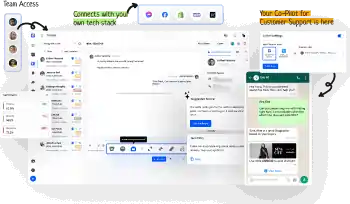A split ticket in customer support means dividing a single support request into multiple tickets. This approach is essential when a customer’s inquiry involves more than one issue or requires input from different teams. For small businesses and SMEs, implementing a split ticketing system can make handling complex customer concerns much easier.
In this post, we’ll explain how split tickets work, why they’re important for customer support, and how they can improve both your team’s workflow and customer satisfaction. Whether you’re new to this concept or looking to optimize your current process, you’ll find actionable insights here.
What is a Split Ticket in Customer Support?
A split ticket happens when a customer support request is divided into two or more separate tickets. This typically occurs when a single inquiry includes multiple issues that need to be resolved by different teams or specialists. Instead of handling everything in one ticket, the problem is broken down for better clarity and resolution.
Example:
Imagine a customer contacts your support team with two concerns: a billing error and a technical issue with your product. A split ticketing system would create separate tickets for each issue—one for the billing team and another for the technical support team. This ensures each problem is addressed by the right experts.
Key Features of Split Ticketing:
- Separation of Concerns: Each ticket focuses on a single issue.
- Individual Ownership: Tickets are assigned to the most appropriate team or agent.
- Enhanced Tracking: Progress for each ticket can be tracked separately.
Splitting tickets avoids confusion, streamlines workflows, and ensures faster resolutions. It’s particularly useful for small businesses managing growing customer needs or diverse support teams.
Why Are Split Tickets Important in Customer Support?
Split tickets bring several benefits to customer support operations, especially for small businesses and SMEs. These advantages are not just operational—they directly impact customer satisfaction and retention.
1. Efficient Problem Resolution
When each issue has its own ticket, teams can work on them simultaneously without interference. This reduces delays and ensures that every concern is addressed promptly. For example, while your billing team corrects an invoice, your technical team can fix a software glitch, cutting overall resolution time.
2. Improved Team Collaboration
Different departments or agents can focus on their expertise, avoiding miscommunication or overlap. By assigning split tickets to the right people, collaboration becomes more organized and productive.
3. Better Customer Experience
Customers value quick and accurate responses. By splitting tickets, you ensure that every part of their concern is handled thoroughly. This builds trust and leaves a positive impression, increasing loyalty.
4. Simplified Tracking and Accountability
Separate tickets allow clear tracking of progress for each issue. It’s easy to see who is handling what, whether the issue is resolved, and where bottlenecks may exist. This transparency also holds team members accountable for their responsibilities.
5. Scalability for Growing Businesses
For SMEs planning to scale, split ticketing helps manage a higher volume of inquiries without sacrificing service quality. It’s a structured approach that keeps things organized as your customer base expands.
Split tickets are not just a tool—they’re a strategy that helps small businesses deliver top-notch support. Up next, let’s explore how to implement split ticketing systems effectively.
How to Implement a Split Ticketing System
For small businesses and SMEs, setting up a split ticketing system doesn’t have to be overwhelming. Here’s a step-by-step guide to help you get started:
1. Choose the Right Customer Support Software
Look for tools that support split ticketing as a feature. Many customer service platforms like Zendesk, Freshdesk, and Zoho Desk offer this functionality. When evaluating software, prioritize features such as:
- Ticket assignment and tracking.
- Automation rules for splitting tickets.
- Reporting tools for performance analysis.
2. Train Your Team
Ensure your team understands the benefits of split tickets and knows how to use the system. Conduct training sessions to explain:
- When to split tickets (e.g., when multiple departments are involved).
- How to assign split tickets efficiently.
- Best practices for following up on individual tickets.
3. Define Clear Workflows
Establish protocols for splitting tickets. For instance:
- Who decides when a ticket should be split?
- How are split tickets prioritized?
- Which team gets which type of ticket?
Having clear workflows prevents confusion and keeps operations running smoothly.
4. Leverage Automation
Automate ticket splitting wherever possible. Many systems allow rules to be set up based on keywords, issue categories, or customer inputs. For example:
- A billing-related keyword triggers a split ticket assigned to the finance team.
- Technical issues are routed directly to the IT department.
5. Monitor and Optimize
Use analytics and feedback to refine your split ticketing process. Look at metrics like ticket resolution time, customer satisfaction scores, and the number of tickets reopened for the same issue. Make adjustments as needed to keep the system efficient.
Tools to Consider:
- Desku: Offers automation and team collaboration features. Best for SMEs and Small Businesses.
- Zendesk: Provides advanced tracking and customization for ticket workflows.
- Zoho Desk: Great for SMEs with its affordability and user-friendly interface.
With the right approach, split ticketing can transform how your small business handles customer support.





